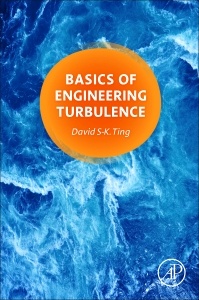Basics of Engineering Turbulence
Auteur : Ting David

Basics of Engineering Turbulence introduces flow turbulence to engineers and engineering students who have a fluid dynamics background, but do not have advanced knowledge on the subject. It covers the basic characteristics of flow turbulence in terms of its many scales. The author uses a pedagogical approach to help readers better understand the fundamentals of turbulence scales, especially how they are derived through the order of magnitude analysis.
This book is intended for those who have an interest in flowing fluids. It provides some background, though of limited scope, on everyday flow turbulence, especially in engineering applications. The book begins with the ?basics? of turbulence which is necessary for any reader being introduced to the subject, followed by several examples of turbulence in engineering applications. This overall approach gives readers all they need to grasp both the fundamentals of turbulence and its applications in practical instances.
Part I: Some Basics of Flow Turbulence 1. Introducing Flow Turbulence2. Equations of Flow Motion3. Statistical Description of Flow Turbulence4. Turbulence Scales5. Turbulence Simulations and Modeling6. Wall Turbulence7. Grid Turbulence8. Vortex DynamicsPart II: Examples of Engineering Problems Involving Flow Turbulence9. Sphere and Circular Cylinder in Cross Flow10. Premixed Turbulent Flame Propagation
Primary: Mechanical, civil, chemical and environmental engineers who encounter flow turbulence in their everyday practice Secondary: Graduate students entering into flow turbulence research
- Focuses on the basics of turbulence for applications in engineering and industrial settings
- Provides an understanding of concepts that are often challenging, such as energy distribution among the turbulent structures, the effective diffusivity, and the theory behind turbulence scales
- Offers a user-friendly approach with clear-and-concise explanations and illustrations, as well as end-of-chapter problems
Date de parution : 02-2016
Ouvrage de 256 p.
15x22.8 cm
Thème de Basics of Engineering Turbulence :
Mots-clés :
aerodynamics; algebraic models; bluff body; boundary layer; buffer zone; central moments; circular cylinder; combustion; convection heat transfer; correlations; covariance; direct numerical simulation; drag; eddy diffusivity; energy cascade; Eulerian; Eulerian-Lagrangian transformation; flatness factor; flow turbulence; grid turbulence; homogeneous and isotropic turbulence; integral scale; Kolmogorov scale; Lagrangian; laminar-turbulent transition; large eddy simulation; law of the wall; logarit



